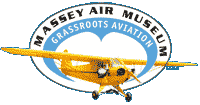
Massey Air Museum wishes to thank Daniel Lance for donating the "replica" Bellanca 14-13 Cruisair (registered N42DJ 1993 LANCE AERO LA421), which belonged to his father, DORRANCE B. LANCE, Alloway Airport (NJ02), Bridgeport, NJ.
We transported the fuselage and tail back to Massey on April 28th, 2016 after having dismantled it the previous month and we will return for the wings shortly. This is aninteresting aircraft, it is registered as Experimental and although the engine is a 3.5 liter Ford V6 conversion (water cooled), the wings and tail appear to be stock Bellanca as does much of the fuselage. The tail endplates appear to be the large ones used on the initial 1946 model with a single upper & lower wire brace of the triple tail. Both the front and rear windows are enlarged with a consequent reduction of the fuselageframe between them. The tube and fabric fuselage and wood wing construction seems to be identical to stock Bellanca.
As part of our "mission" the Massey Air Museum would like to feature the history and aircraft of our region, both Maryland and Delaware. Bellanca Aircraft, is an important part of Delaware aviation history and we are very happy to have this example aircraft, albeit not strictly Bellanca, it is representative. It will be on display at Massey and although it was always hangared and was flyable (although out of annual)there are no immediate plans to fly it.
Giuseppe Bellanca was enshrined in the National Aviation Hall of Fame in 1993. See Biography: http://www.nationalaviation.org/bellanca-giuseppe/
The Bellanca Aircraft Corporation of America (1927 - 1954) was founded in 1927 byGiuseppe Mario Bellanca (1886-1960) and moved to New Castle, DE in 1928.
Bellanca had joined the Wright Aero Corporation of New Jersey in 1924 as a consultant. The Wright Company was looking for a plane to showcase its new J-5 Whirlwind engine. Bellanca answered their call by building the Wright-Bellanca WB-2, a plane that swept the air races in 1926 and set a non-refueled endurance record of 51hours. Many people believed this plane would make the first trans-Atlantic crossing. Lindbergh’s first choice for his New York to Paris flight was the Bellanca WB-2. Thecompany's insistence on selecting the crew (not wanting Lindbergh to pilot) drove Li ndbergh to choose Ryan instead. (Wikipedia)
Bellanca remained President and Chairman of the Board from the corporation's inception on the last day of 1927 until he sold the company to L. Albert and Sons in1954 when production moved to Minnesota. From that time on, the Bellanca line was part of a succession of companies that maintained the lineage of the original aircraft produced by Bellanca. (Wikipedia)
Bellanca, as a name, is nearly as old as aviation. Guiseppe was building some of the most useable airplanes in the world long before North American was born, before Bill Piper decided to get into the airplane business and before Clyde Cessna, LloydStearman and Walter Beech were anything other than Travel Air employees,Bellanca's Pacemaker and Skyrocket designs were working machines that may nothave been as famous as many, but they were respected by those who used and flewthem. We were well into the 1980s before the last Bellanca was retired in the Canadian/Alaskan bush. And none of them were much less than 60 years old! (Budd Davisson, "We Fly the Cardboard Constellation.") Air Progress Vintage Buyer's Guide
http://www.airbum.com/pireps/PirepBellancaCruisair.html

========================================================================
BELLANCA AIRFIELD & DELAWARE AVIATION HALL OF FAME MUSEUM
2016 OPEN HOUSE SCHEDULE: Free admission (donations welcome).
From 11 to 3 p.m. on April 9 & 23, May 14 & 28, June 11 & 25, July 9 & 23, Aug 13 & 27, Sept 10 & 24, Oct 8 & 22.
The Bellanca Airfield Hangar is located at the intersection of Route 273 andCenterpoint Blvd. in New Castle, Delaware. It is one mile east of the New Castle Farmers Market on Route 13 and one mile west of the Old Courthouse in New Castle, DE - next to Amazon. For information call: (302)762-9057 or (302) 999-8623.
Visit their website at www.friendsofbellanca.org
========================================================================
The Bellanca 14-13 Cruisair Senior and its successors are a family of light aircraft that were manufactured in the United States by AviaBellanca Aircraft after World War II. They were a follow-on to the pre-war Bellanca 14-7 and its derivatives. While retaining the Bellanca 14-7's basic design, the 14-13 featured an enlarged cabin, a horizontally opposed Franklin 6A4-335-B3 150 hp engine in place of the earlier models' Le Blond radial and anoval vertical endplate on each horizontal stabilizer. This latter feature gained the type theaffectionate nickname "cardboard Constellation", because the arrangement is similar to thecontemporary Lockheed Constellation airliner. Taking its name from the Bellanca tradition of identifying the series from the wing area in square feet, dropping the final digit, while thesecond number is the aircraft's horsepower, again dropping the final digit, the 14-13 does notquite fit the naming convention. The Bellanca 14-13 wing is constructed of wood, while the fuselage is welded steel-tube framework with a fabric covering.The 14-13 was introduced in 1946; in its improved 14-13-3 version the aircraft remained inproduction until 1956. Approx. 600 were produced. (Wikipedia)
General characteristics & Performance
- Crew: one pilot Capacity: 3 passengers
- Length: 21 ft 4 in (6.5 m)
- Wingspan: 34 ft 2 in (10.42 m)
- Height: 6 ft 3 in (1.91 m)
- Gross weight: 2,150 lb (975 kg)
- Powerplant: 1 x Franklin 6A4-150-B3, 150 hp
- Maximum speed: 165 mph (266 km/h)
- Range: 600 miles (970 km)
- Service ceiling: 16,000 ft (4,900 m) (Wikipedia)

SKYWAYS magazine May 1946
March 29, 2016 Dismantling of replica Bellanca N42DL





FLYING magazine December 1946

2016, Massey Air Museum
